Video Uprising
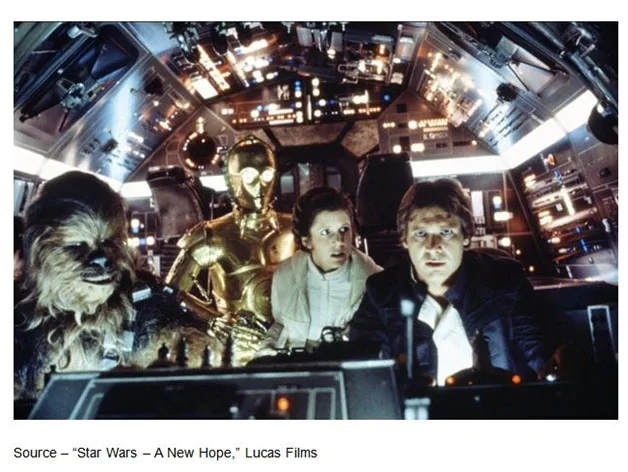
This year’s NAB (National Association of Broadcasters) show was information packed, exciting, interesting, fun and stressful–all at the same time. It was a reflection of an entire industry in the throws of change and honestly, it will probably take three Content Insiders to properly discuss the finer points.
Let’s get the “fun” part out of the way. There were a lot of drones being shown and almost everyone – filmmakers, producers, news departments, theater moguls and network/station executives were thinking of a hundred reasons why they needed at least one of the drones but most were thinking of a fleet.
The reasons came fast and furious: indoor shoots (they now have GPS – global positioning systems – on them), dramatic angle shots, aerial cut-aways, exciting SAR (search and rescue) images and one-time blow-‘em -up footage.
Unlike the CES (Consumer Electronics Show), they weren’t just cute toys. These were working tools and with prices already under $1K, you’ll be seeing some super entertainment, news coverage soon.
The only catch is finding enough certified pilots and Federal clearance for use in things such as news shoots (think 2017). But little things like that won’t keep news and production teams from drooling and dreaming.
Of course, if the U.S. FAA (Federal Aviation Agency) keeps fumbling to give show/feature people permission to fly drones for the projects, we’ll probably see a lot of projects move “offshore.”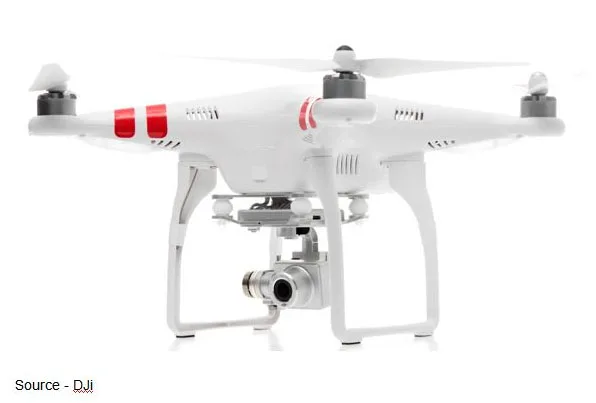
Lift Off – While DJi got their best publicity when someone crashed their quadcopter on the White House lawn, their showing at NAB was anything but a drunken flight. The world’s leading personal drone producer showed the news and entertainment industry they were ready to deliver those OMG shots. Drones will be a boon to filmmakers and news departments, once the FAA and global agencies allow flights over populated areas.
While the drones were the show’s gotta’ see stuff, the real substance of the show was that everything – and we mean everything – about the industry is changing.
Tom Wheeler, FCC (Federal Communications Commission) chairman did his share of lobbying at the show that net neutrality was going to be good for everyone … including the consumer, “free from the risk of discrimination or hold-up by a gatekeeper.”
It was a great message and looks like all the countries around the globe are going to push it as well.
Still, don’t expect that folks who own the infrastructure will roll over and give in without a lot of lawyers heading to court.
Obviously, service providers care because they have skin in the game; but since traditional broadcast is quickly going OTT (over the top), IP (Internet Protocol) content producers, marketers and distributors are also more than a little interested.
They’re just not exactly sure why yet because the old money factory is being torn down board by board.
Netflix’s Reed Hastings thinks it’s the best way to quickly put a stake in yesterday’s TV activities.
The biggest cloudy discussions at NAB were how to get all of the content being produced over to the IP network and how to make money doing it.
Solutions for bringing TV and computers together were everywhere. There wasn’t a production solution being shown – Harmonic, AJA, Quantum – you name it, that didn’t have an IP-ready solution to produce the stuff … they just didn’t bother talking about how folks were going to charge for it.
Not that there aren’t enough people offering delivery – Netflix (obviously), Hulu, Playstation Vue, Apple TV, HBO Now, CBS All Access, Nickelodeon and Amazon Prime – all had siloed solutions but the channel consolidators are still working on their offerings.
I ran the numbers and boy, it looks like I’ll have a viewing bill right back up there with my old cable bundle! But with a lot more freedom of choice.
While content distribution occupied most of the heated session discussions, the eye candy for the show was the fantastic 4K/8K and future cameras.
HD? Don’t even ask. They were gathering dust over in the corner.
Why not? The new 4K cameras were packed with some of the sweetest technology you could imagine and the prices were “reasonable” even for the units from Sony, Panasonic, JVC and Red.
I tried to find a few friends at the Blackmagic booth but you had a hard time even waving to them in the company’s overpacked booth. Whether it was a studio camera, field unit or their new little Micro Cinema Camera, the Aussies know where the sweet spot of the market is.
Yes, the GoPro has been at the top of the heap because it’s compact and light; but the new Micro Cinema will give it a serious run for your money!
As Darth Vader observed, “The Force is strong with this one.”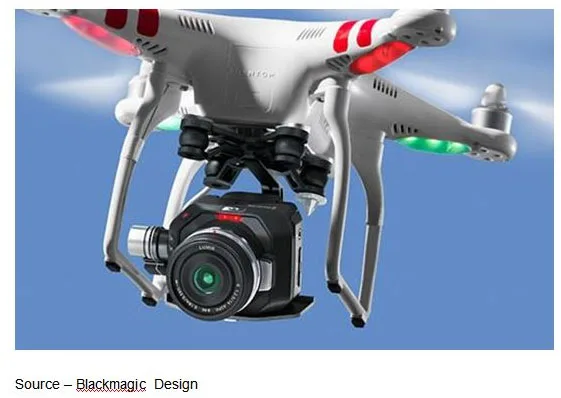
Magic Flight – GoPro has been the key supplier to people who want to shoot dramatic aerial film scenes and stills and will be the undisputed leader when it comes to really, really rough environments. But Blackmagic showed NAB attendees that quality images don’t have to come from a heavy camera with their new Micro Cinema 4K camera that grabs great 1080p RAW content.
The Micro Cinema shoots 1080P RAW content and does a beautiful job. My only complaint about it – strictly personal – is that it only uses SD cards and I really like their larger cameras that use certified SSD (solid state drives) that have more storage capacity and are reasonably priced.
1TB capacity just gives me more shooting time before having to dump the content to a field-ready, bigger capacity unit.
And we all know how much storage 4K and on up sucks up.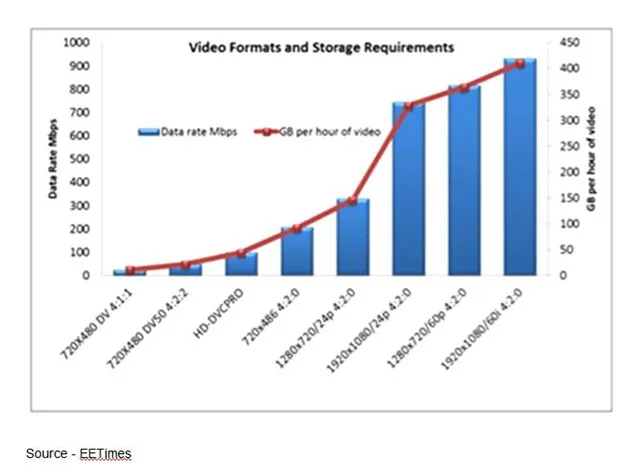
Big ‘n Beautiful – The rapid move to 4K cameras, content, streaming isn’t just a vision in a far off galaxy, it’s here now! While everyone likes the projected imagery, storage folks see a huge demand for volumes of SSD and HDs where performance and quality are more important than price.
You can say it’s all about the quality you capture and how you edit it that makes a film great; but when it gets dark out, that content has to have some place to rest/sleep … that’s storage.
The new cameras are so economical today that producers/directors come up with storyline ideas that include blowing things up with cameras inside, crash scenes, sand storms and general abuse so that even if the camera is destroyed, the content is captured.
Try doing that with a hard drive or piece of old-fashioned film?
When there’s only one take SSD isn’t just a good solution … it’s the only solution.
Darth Vader looked at the solution and said, “The circle is now complete.”
The big part of the show was how to get all the content ready for viewers, and IP is winning hands down.
Big Budget Creation – News departments, syndicated shows and major movie productions rely on high performance and flexible workflow hardware/software. It allows them to process and manage the workflow from ingest to distribution and increasingly, in every format for the growing family of viewing options.
All of the production/post production forces (for broadcast, studios) were showing IP components and system that were totally 4K ready.
IP is a natural for content producers – cheap, common, reliable and can be used almost everywhere. That makes it fast and easy for studios to add components as needed–even for remote work.
None of the attendees were really interested in the public network because it’s too easy to be hacked and hijacked. That’s why people like Harmonic had a very strong private IP solution, but all were at least semi-proprietary.
Security was the key selling point everyone offered!
Several of the folks were showing Cat-6 and IP network solutions that were easily handling uncompressed 4K video (tons of data moving through the wires), so the options are there.
Because production budgets have become so tight, few studios have all of the work done in-house but use specialty shops for rendering, FX (special effects), coloration, audio enhancement, etc.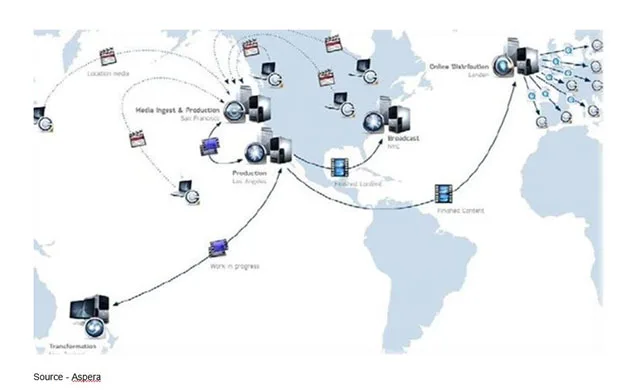
Budget Management – Today’s production organizations no longer have large staffs of specialists to handle editing, coloration, FX, audio enhancement and the other things that need to be done to make good video great. Increasingly, they rely on skilled specialists around the globe. Even low-budget content is moved from one location to another so people can work their magic. While working in the cloud is a nice idea, the combination of bandwidth instability and hacking/hijacking keeps delivery services busy … everywhere.
So security and bandwidth were big concerns for executives and engineering and obviously, the cloud solution providers had the answers.
Dropping a file into a New Zealand expert’s facility that must then move to London, then New York City and finally Hollywood means people can’t afford to be too careful, so encryption and a lot of faith still seems to be involved in the workflow.
I guess that’s why FedEx, UPS and DHL still do such a thriving business moving stacks of hard drives around the globe.
While Blackmagic is making some serious inroads into the full production process, especially with their new DaVinci Resolve, Adobe Production Premium continues to be the solution of choice most of the people at NAB wanted to see.
They just seem to talk the same language as the production, post, color, FX, composite people.
And they are constantly developing great new tools people can actually use out of the box (actually, the cloud; but what the heck).
Everyone who’s anyone is shooting and producing in 4K and HDR (high dynamic range) and now that there are super cheap 4K UHD (ultra high definition) sets like those Vizio recently announced (under $800), there are plenty of targets for the content.
In fact, sales for 4K sets (even before the latest round of announcements) increased over 600 percent this year and the new round of price reductions can only accelerate adoption.
That’s a good thing for the production hardware/software folks because it means another surge of buying solutions to produce the stuff you want to watch on whatever your IP channel might be.
It also means a surge in the purchase of storage – solid state and hard drives.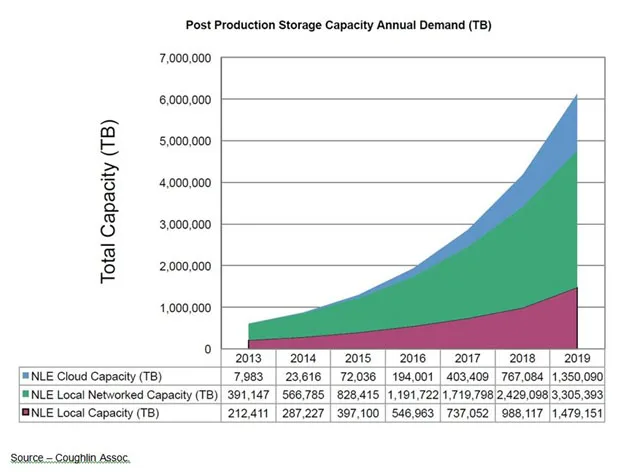
Close to Home – Filmmakers are proud of their work and private about it. While cloud storage folks keep telling them how much money they will save by storing rich content with them, few production companies and Indies are willing to risk all of their work to a bunch of strangers. The costs of local storage may be more than the cloud, but reshooting (if it’s even possible) is a helluva’ lot more expensive.
You didn’t see executives, producers and directors hanging around the storage-centric booths at the show because that stuff is beneath them.
But the folks who have to do the real work were crowding around booths such as Quantum’s if they had big project budgets or OWC’s Jupiter/Callisto area if they had low-medium budgets.
Walking the floor, I was surprised how many of the production folks were looking for project- specific storage – 12 – 32TB boxes they could use once for the complete project and then archive in the back room.
And the capacity ramps up very quickly since for an hour of actual film, more than 60 percent of the projects will capture 2-10 hours of content so you have 8-10TB of 4K content you need to save and protect.
Every production operation has two budgets – fiscal and time, so capacity and performance are key storage considerations, which also means everyone was asking for Thunderbolt 2 connections.
Bottom of Form
So tapping into and sending huge 4K files to storage quickly is critical and Thunderbolt 2 can move content at 1.3GB/s so that can be a real time saver.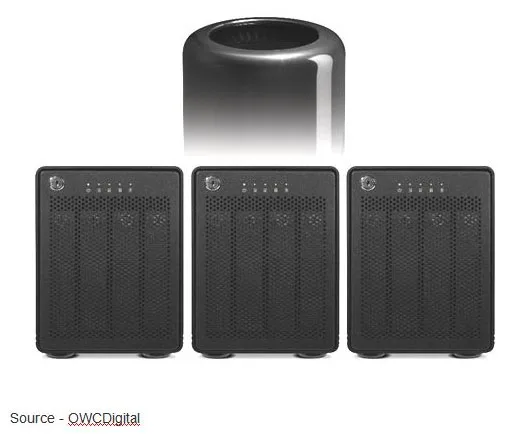
Workspace – Whether it’s an Indie or higher budget project, costs have come down and performances as well as ease of use have gone up, putting tremendous storage capacity next to your workstation. With high-speed, high-performance Thunderbolt 2 connections, film people will rarely run out of capacity because it is fast, easy and almost cheap to grow storage capacity by daisy chaining more units.
The great thing about Thunderbolt 2 is that you can daisy chain up to six devices so when one storage unit fills up, you simply hang another one on it without missing a beat.
There’s just an awesome feeling of power with having access to 100TB of deep, rich content sitting at your workstation.
Of course, Hans Solo added, “I don’t know, I can imagine quite a bit.”
Storage – in your hand, desktop or rackmounted – is just incredibly inexpensive compared to just a year or two ago. It’s come together at just the right time for today’s 4K stream-it-anywhere to any device world.
Everyone at the show seemed to agree that IP OTT delivery is rapidly making linear TV something that won’t survive many more years; but that’s also a major concern in some parts of the world.
While Netflix’s Hastings is pushing his firm to be a major content provider everywhere, several NAB attendees saw IP delivery as a major concern.
The MENA (Middle East and North African) market isn’t the same as the Americas, European and Pacific Basin areas. And IP OTT is a big concern when borders disappear.
OTT is a fantastic global content platform for people to pick and choose the stuff they want to watch (legal or not); but it’s also making some country officials (and content owners) more than a little uneasy.
Now that folks can watch 4K content on everything from TV sets to smartphones, some of the stuff coming over the air isn’t permitted for viewing in some countries.
Boomer/boomer- plus folks will continue to watch whatever is on their set, but the kids in the family will sit there with their whatever device watching what they want, when they want to watch it.
Whether it’s legal or not licensed in a certain country/region, it’s going to be very hard to stop folks … forbidden fruit always tastes best!
 Trying to ignore the inevitable, a lot of film, network, station managers will stumble forward and repeat Hans Solo, “Uh, everything’s under control. Situation normal.”
Trying to ignore the inevitable, a lot of film, network, station managers will stumble forward and repeat Hans Solo, “Uh, everything’s under control. Situation normal.”